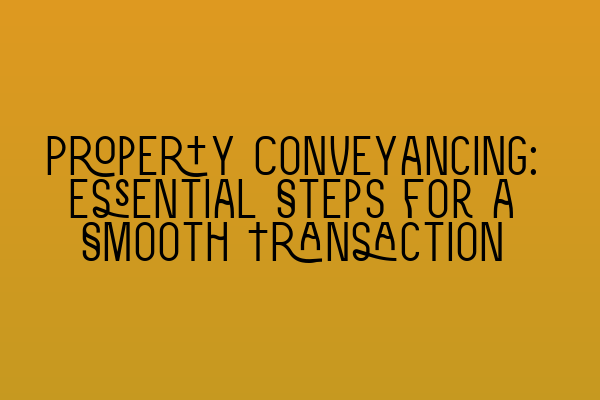Property Conveyancing: Essential Steps for a Smooth Transaction
Are you buying or selling a property? If so, you know that property conveyancing is an essential step in the process. Property conveyancing involves the transfer of legal ownership from one party to another, and it can be a complex and time-consuming process. However, with the right knowledge and guidance, you can ensure a smooth transaction. In this blog post, we will outline the essential steps for property conveyancing and provide insights into how you can navigate this process successfully.
Step 1: Instruction
The first step in property conveyancing is to instruct a conveyancing solicitor. A qualified solicitor will act on your behalf to handle all legal matters related to your property transaction. It is crucial to choose a solicitor who specializes in property law, as they will have the expertise and experience needed to guide you through the process.
Step 2: Property Search
Once you have instructed a solicitor, they will conduct a thorough property search. This search involves investigating various factors, such as title deeds, planning permission, building regulations, and environmental searches. These searches aim to uncover any potential issues or restrictions that may affect the property. It is essential to address these issues early on to avoid complications later in the conveyancing process.
Step 3: Drafting and Reviewing Contracts
The next step in property conveyancing is the drafting and reviewing of contracts. The buyer’s solicitor will prepare a draft contract that outlines the terms and conditions of the sale. The seller’s solicitor will then review the contract and suggest any necessary amendments. It is crucial to ensure that the contract is fair and includes all the essential details, such as the purchase price, completion date, and any additional conditions.
Step 4: Negotiating and Exchanging Contracts
Once both parties are satisfied with the contract, the next step is to negotiate and exchange contracts. During this stage, the solicitors representing the buyer and seller will negotiate any outstanding issues, such as repairs or additional requests. Once the parties have reached an agreement, they will exchange contracts. At this point, the transaction becomes legally binding, and both parties are committed to completing the sale.
Step 5: Completion and Transfer of Ownership
Completion is the final step in the property conveyancing process. On the agreed date, the buyer’s solicitor will transfer the purchase funds to the seller’s solicitor. Once the funds have been received, the seller’s solicitor will confirm that the property’s legal ownership has transferred to the buyer. The buyer will then receive the keys to the property and can take possession.
It is worth noting that property conveyancing can involve additional steps and considerations depending on the specific circumstances of the transaction. The process may also vary across different jurisdictions. Therefore, it is important to seek professional advice to ensure compliance with local laws and regulations.
In conclusion, property conveyancing is a vital process in buying or selling a property. By understanding the essential steps involved and seeking the guidance of a qualified conveyancing solicitor, you can ensure a smooth and successful transaction.
If you would like to learn more about contract law or other related topics, please check out the following articles:
– Misrepresentation in Contracts: Unveiling Deceptive Practices
– A Closer Look at SQE Contract Law Syllabus
– SQE Contract Law: Analyzing Landmark Cases and Influential Judicial Decisions
– Understanding Contractual Capacity: Rights and Limitations
– Interactive SQE Mock Tests for Contract Law: Test Your Knowledge
Remember, property conveyancing is a complex process, and it is crucial to seek professional advice to ensure a smooth and stress-free transaction.
